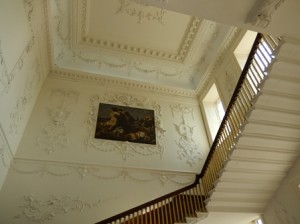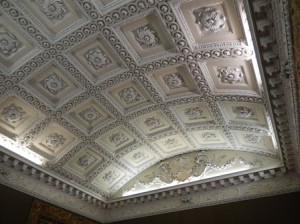22 Of Chandeliers and Plasterwork
Posted by Christine on Nov 16, 2014 in Ireland | 4 comments
One of the best things about travel is learning to appreciate things—abstract things and thing things—you might never learn to appreciate at home. And by travel I mean a trip to the next town over, or to a café or grocery store on the other side of your own town, as well as travel that includes long distances, strange new ways of doing things, and languages you don’t speak. You just need to change your perspective, look through others’ eyes, ponder assemblages of things and ideas that are not your own.
Accompanying students to Ireland every other year as I do, I have lots of opportunities to see them make those leaps of cultural realization that travel brings about, but I also love to see a student kick open a door in her mind when something more everyday about Ireland catches her imagination, whether it’s sitting by a real turf fire, developing a love for the sport of hurling, or  learning everything she can about the stone walls that divide the fields throughout the country.
learning everything she can about the stone walls that divide the fields throughout the country.
Of course I have these experiences, too. Did you know that everywhere I travel I am fascinated by sewer and manhole covers? They are usually designed with care, reflecting the taste and era of the region and the age. I also love to study how items in the grocery store or pharmacy are arranged in different places around the world. I’m mad for china cabinets, especially the kind without doors displaying rows of plates, cups and saucers, and pitchers. The list goes on.
Spending a year in Ireland has given me the opportunity to dig a little deeper in my learning about the country and also to develop and explore my own strange interests and obsessions. From recent visits to some of the great houses—of which there are remarkably few here in Ireland, a story I promise to tell in another post—I have been wanting to write about two things that I surprised myself by falling in love with, two art forms that are often seen together: chandeliers and decorative plasterwork.
That I love chandeliers probably won’t surprise you. Ireland is the home of Waterford Crystal, and even if you think that crystal glassware is a waste of money on things that easily break, it’s hard to ignore the sparkle and magic of beautiful crystal chandelier, lighting up a room, reflecting and refracting its colors and shapes. My appreciation of chandeliers did begin with Waterford. Watching the craftsmen at work in the factory in Waterford will make anyone more able to appreciate and more willing to pay for the final product. A lengthy process defines every piece produced there: each one is handled by many skilled workers with years of training among them, inspected again and again, and held to rigid standards before being released for sale. The artisans obviously love their work. Now that Waterford has downsized, their former employees have set up their own glass studios around the country. This is craftsmanship at its best.
But I’m really talking about chandeliers hanging in rooms they were designed for, like the spectacular Austrian chandelier in the main stairwell at Russborough House pictured above, longer and deeper than most to light the several stories and the stunning plasterwork hunt scenes that decorate this out-of-the-way part of the house. Attention to detail, craftsmanship, and the idea that even someone going up and down the stairs ought to have something beautiful to look at make this a quite extraordinary part of the house. When I see places like this, I realize the artistry in all of us as we create environments that reflect who we are.
The dazzling, multicolored chandeliers at Castletown House were purchased in the eighteenth century by the lady of the house Louisa Connolly. Hung in the Long Gallery, they complimented  the bright paint and elegant furniture chosen for the room, lighting up many a ball, musical evening, and conversation. Even when the rest of the house had fallen into decay, because they were hung so high up the chandeliers remained in fine condition and were easily restored recently by visiting experts from Murano, in Venice, where they were made almost two hundred and fifty years earlier. The Murano people were apparently astonished to find a rare set of three of these chandeliers intact and excited about working on them, as craftsmen are. Although they are only light fixtures, the delicacy and grace of each shape, the elegance of each arrangement as a whole, and the spectacular way the three chandeliers together light up the room make them works of art. I would have loved to have seen them sparkle with the flickering light of candles.
the bright paint and elegant furniture chosen for the room, lighting up many a ball, musical evening, and conversation. Even when the rest of the house had fallen into decay, because they were hung so high up the chandeliers remained in fine condition and were easily restored recently by visiting experts from Murano, in Venice, where they were made almost two hundred and fifty years earlier. The Murano people were apparently astonished to find a rare set of three of these chandeliers intact and excited about working on them, as craftsmen are. Although they are only light fixtures, the delicacy and grace of each shape, the elegance of each arrangement as a whole, and the spectacular way the three chandeliers together light up the room make them works of art. I would have loved to have seen them sparkle with the flickering light of candles.
It was at Russborough House, another palladian mansion near Dublin, that I learned to appreciate decorative plasterwork, something I had taken for granted for many years before really understanding what it was all about. Plasterwork—the decorative borders, designs, and images shaped by hand as at Russborough or molded from plaster on ceilings, crown mouldings, and other structural parts of a room—is a unique art in that it must complement and enhance a room without dominating it. Plasterwork is a rather ornate fashion that has come and gone, but that makes perfect sense when you see it in situ, not the first thing you look at when you go into a room, but after taking in the whole, you look up with a gasp at the beautiful creation floating above you and understand at last why the room is so stunning. Then you can’t take your eyes away. And no wonder, for the work of the Swiss Lafranchini brothers, Paul (1695–1776) and Philip (1702–1779), distinguishes Russborough and several other Irish palladian homes from similar houses of the era throughout Europe, so much so that Trinity College recently held a conference on plasterwork here in Dublin.
Why is the work of the Lafranchini brothers and other master plasterwork artists of the eighteenth century so compelling? Fashioned by hand, their designs have the freshness and uniqueness of the original vision. The thick shapes look light and airy, like sculpted whipped cream, defying gravity and common sense. The deep relief of their swirls, leaves, flowers, and vines makes it seem like there’s another world above us, only half visible but obviously more perfect than our own.
Put a beautiful chandelier together with an elegantly worked decorative plaster ceiling and you’ve given the room a magnificent crown, completing its ensemble of color, texture, and design and directing our gaze upward to higher and better things.

Plasterwork ceiling and frames for four marine scenes by Joseph Vernet (1714-1789) and eighteenth-century English chandelier, Russborough House. The paintings–the only works that could fit the frames–were missing for decades and finally found in the 1960s leaning against a wall in a New York gallery.




What an astute lover of material culture!!!! Your blog is a joy to read.
Thank you so much for reading and posting comments. It means a lot!
Another great post. Thanks.
At risk of being redundant, I add my appreciation for the great descriptive and informative tour that reminds us to also look to the “world above” – my favorite line: “The thick shapes look light and airy, like sculpted whipped cream, defying gravity and common sense.” Thanks.